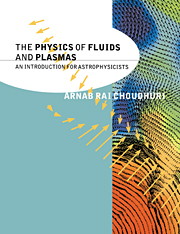Book contents
- Frontmatter
- Contents
- Preface
- Acknowledgements
- Introduction
- Part I Neutral fluids
- Part 2 Plasmas
- 10 Plasma orbit theory
- 11 Dynamics of many charged particles
- 12 Collisionless processes in plasmas
- 13 Collisional processes and the one-fluid model
- 14 Basic magnetohydrodynamics
- 15 Theory of magnetic topologies
- 16 Dynamo theory
- Epilogue
- Appendix A Useful vector relations
- Appendix B Integrals in kinetic theory
- Appendix C Formulae and equations in cylindrical and spherical coordinates
- Appendix D Values of various quantities
- Appendix E Basic parameters pertaining to plasmas
- Suggestions for further reading
- References
- Index
12 - Collisionless processes in plasmas
from Part 2 - Plasmas
Published online by Cambridge University Press: 05 June 2012
- Frontmatter
- Contents
- Preface
- Acknowledgements
- Introduction
- Part I Neutral fluids
- Part 2 Plasmas
- 10 Plasma orbit theory
- 11 Dynamics of many charged particles
- 12 Collisionless processes in plasmas
- 13 Collisional processes and the one-fluid model
- 14 Basic magnetohydrodynamics
- 15 Theory of magnetic topologies
- 16 Dynamo theory
- Epilogue
- Appendix A Useful vector relations
- Appendix B Integrals in kinetic theory
- Appendix C Formulae and equations in cylindrical and spherical coordinates
- Appendix D Values of various quantities
- Appendix E Basic parameters pertaining to plasmas
- Suggestions for further reading
- References
- Index
Summary
Introduction
In this chapter, we shall mainly study what happens when a plasma in thermodynamic equilibrium is slightly disturbed. If the effect of collisions can be neglected in studying the evolution of the disturbance, then we call it a collisionless process. In stellar dynamics, one often studies systems with relaxation times larger than the age of the Universe so that collisions have never been important in the system. Here, however, we shall consider plasmas which are close to thermodynamic equilibrium presumably as a result of collisions. But collisions happen to be unimportant in the particular processes we are going to look at.
If a plasma is close to thermodynamic equilibrium, then hydrodynamic models may be applicable as we pointed out in §11.5. We shall mostly use the two-fluid model which was developed in the previous chapter. Only §12.4 will provide an example of how calculations can be done with the help of the Vlasov equation. We shall see that the Vlasov equation can give rise to a conclusion different from what we get by using the two-fluid model due to rather subtle reasons.
We shall mainly consider waves of high frequencies (so that collisions are unlikely to occur during a period of the wave), as such waves are the most important examples of collisionless processes. For low-frequency processes (with frequency ≪ the plasma frequency ωp defined in §12.2), we shall see in later chapters that charge separation can be neglected and the plasma may be regarded as a single fluid.
- Type
- Chapter
- Information
- The Physics of Fluids and PlasmasAn Introduction for Astrophysicists, pp. 238 - 257Publisher: Cambridge University PressPrint publication year: 1998



